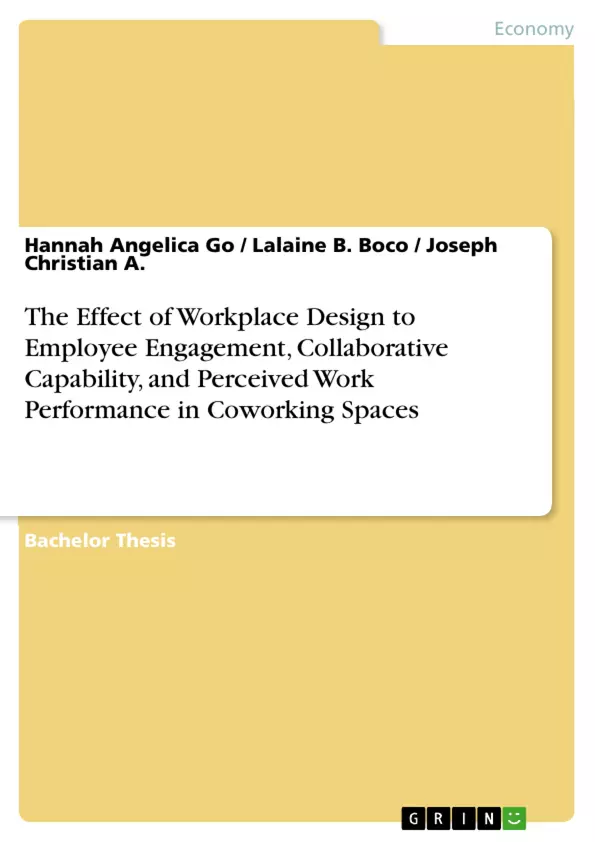The Coworking space phenomenon is rapidly growing across the countries of North America, Europe, and Asia. Owing to its functional work environment, it offers coworkers a collaborative atmosphere that makes them more involved at work. The research study aims to describe the causal relationship of workplace design to perceived work performance and to employee engagement and collaborative capability as mediating variables through the use of Structural Equation Modeling (SEM).
A total of 350 coworkers aged 18-60 years old, from 27 different coworking spaces in Metro Manila, Philippines participated in the study. The findings of this research revealed that workplace design has no direct effect on perceived work performance; hence, perceived work performance improves when coworkers are more engaged and have better collaborative capability. Nonetheless, the rest of the hypothesized premises were affirmed in the result of this study.
This paper can help the HR managers and the business centers to create a more flexible and constructive workplace setting for their employees. Further, the results can be used as a basis for the fundamental shift of the traditional workspace into a new creative workplace.
Inhaltsverzeichnis (Table of Contents)
- INTRODUCTION
- THEORETICAL FRAMEWORK
- REVIEW OF RELATED LITERATURE
- Workplace Design
- Employee Engagement
- Collaborative Capability
- Perceived Work Performance
- The Hypothesized Model
- METHOD
- Design
- Sample and Study Site
- Instrumentation
- Data Gathering Procedure and Ethical Consideration
- Data Analysis
- RESULTS
- DISCUSSION
Zielsetzung und Themenschwerpunkte (Objectives and Key Themes)
This research study investigates the causal relationship between workplace design and perceived work performance, exploring the mediating roles of employee engagement and collaborative capability. The study utilizes Structural Equation Modeling (SEM) to analyze data collected from 350 coworkers in various coworking spaces across Metro Manila, Philippines.
- The impact of workplace design on employee engagement and collaborative capability.
- The mediating effect of employee engagement and collaborative capability on the relationship between workplace design and perceived work performance.
- The role of coworking spaces in fostering a creative and collaborative work environment.
- The potential benefits of incorporating modern and flexible workplace designs in corporate offices.
- The importance of workplace design in promoting employee well-being, productivity, and business success.
Zusammenfassung der Kapitel (Chapter Summaries)
- INTRODUCTION: This chapter introduces the study's context, highlighting the evolving nature of the work environment, the rise of coworking spaces, and the influence of workplace design on employee performance. It explores the benefits of coworking spaces, such as flexibility, collaboration, and networking opportunities, emphasizing the shift towards creative and collaborative work environments.
- THEORETICAL FRAMEWORK: This chapter outlines the theoretical foundation of the study, drawing on Yerkes-Dodson's fundamental theory and Herzberg's Motivation-Hygiene Theory to explain the relationship between performance and arousal, and the motivational factors that influence employee behavior in the workplace.
- REVIEW OF RELATED LITERATURE: This chapter delves into the relevant literature on workplace design, employee engagement, collaborative capability, and perceived work performance, providing insights into the key concepts and their interconnections. It also presents the study's hypotheses, proposing relationships between workplace design, employee engagement, collaborative capability, and perceived work performance.
- METHOD: This chapter outlines the research methodology, including the study design, sample selection, data collection procedures, instruments used, and data analysis techniques.
Schlüsselwörter (Keywords)
The core concepts and themes explored in this research include coworking spaces, workplace design, employee engagement, collaborative capability, and perceived work performance. The study focuses on understanding the influence of workplace design on employee engagement and collaborative capability, and how these factors mediate the relationship between workplace design and perceived work performance.
- Quote paper
- Hannah Angelica Go (Author), Lalaine B. Boco (Author), Joseph Christian A. (Author), 2018, The Effect of Workplace Design to Employee Engagement, Collaborative Capability, and Perceived Work Performance in Coworking Spaces, Munich, GRIN Verlag, https://www.grin.com/document/416069



